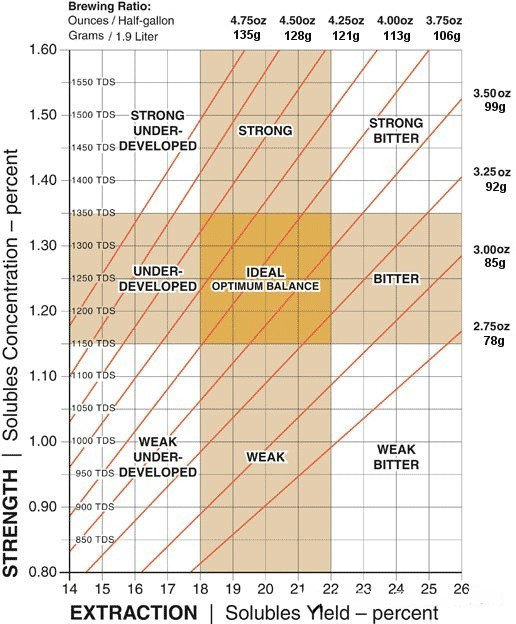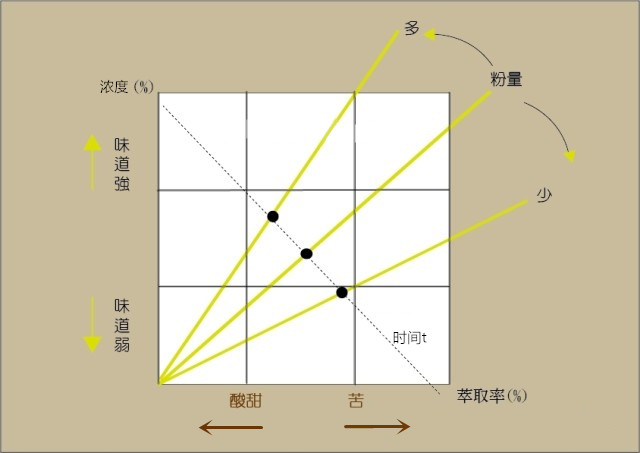Coffee extracted by SCAA Gold Cup identifies the distribution of sour, sweet, bitter and salty on the tip of the tongue
Since the data is not important, what is important? The effect of extraction rate on taste, of course. When you have a thorough understanding of the relationship between the extraction rate and the taste trend, it will definitely be of great help to your cooking adjustment.

Let's take a look at this diagram. The data of vertical axis and horizontal axis are removed and replaced by the relationship between concentration taste and extraction rate taste. When the coffee concentration is high, you will feel that the overall taste is stronger, and vice versa. The most interesting thing is that when the extraction rate is low, the sweet and sour feeling will be more obvious, while when the extraction rate becomes higher, the bitterness will be more obvious.
The diagonal line in the figure is the relationship between extraction rate and concentration when cooking with a fixed amount of powder. When the extraction rate of coffee increases, so does the concentration of coffee. In other words, compared with the relationship between the concentration and the extraction rate that we replaced, we can draw a very simple conclusion: with the increase of the extraction rate, the taste of coffee will become stronger and stronger, and the taste will be more sour and sweet from the beginning. slowly become bitterness accompanied by bitterness, and even only bitterness in the end.
If you have the spirit of experiment, I suggest you try to verify it by cup test. Pick up the coffee beans you have at hand and soak them with the same ratio of powder to hot water (the ratio of powder to water is the same as the ratio of coffee you usually make). Soak the first cup for one minute and then break the dregs, or you can use a filter cup to filter out the coffee grounds. The second cup is soaked in two points, and the third cup is three points. In this way, you can get the coffee at the three spots A, B and C in the picture, and then try to drink it to see if it is the same as what you just said.

First of all, let's take a look at the distribution of taste buds. During the tasting process, you can recall this picture and focus on two things, the first is the intensity of the sweet and sour, and the second is the location of the sweet and sour. The taste buds that can feel sour taste are mostly on both sides of the tongue and extend to the front of the tongue, while the sweet taste buds are distributed in the front of the tongue. Bitter taste buds are distributed in the root of the tongue, the right amount of bitterness can bring out a long throat rhyme. Let's not talk about salty taste for the time being, because salty taste is not a very pleasant taste in the field of coffee. In the tasting experiment of golden cup theory, we just focus on the relationship between sweet and sour taste and extraction rate.
After tasting, it should be emphasized here that the so-called extraction rate is low, sour and sweet is more obvious, and the high extraction rate is more bitter, which refers to the ratio between sour, sweet and bitter, rather than absolute strength. For example, the sweet and sour "intensity" of extraction point B is sometimes higher than that of extraction point A, just because extraction point B is accompanied by bitterness, so when drinking, the proportion of sweet and sour taste becomes lower in all the tastes. there will be the illusion that sweet and sour feelings become less obvious.
Therefore, under the same amount of powder and extraction structure, with the increase of the extraction rate, the taste of coffee will become stronger and stronger, and the taste will be more obvious from the beginning, and gradually become bitter, accompanied by bitterness, and even leave only bitter taste in the end.
Source: Beresta's blog
Important Notice :
前街咖啡 FrontStreet Coffee has moved to new addredd:
FrontStreet Coffee Address: 315,Donghua East Road,GuangZhou
Tel:020 38364473
- Prev

Calculation method of SCAA Gold Cup extraction theoretical Coffee extraction rate calculation of correct extraction
You can refer to the above chart, which is a standard gold cup theory chart (also known as extraction control chart; Brewing Control Chart,SCAA). Do you feel dazzled? It doesn't matter. Let's talk about what this picture is going to say in a simpler way. Then let's go on to look at the picture above. We will send some unnecessary letters.
- Next

The ratio of powder to water extracted by SCAA gold cup the effect of excessive extraction on the quality of coffee
Then let's talk about the effect of powder on coffee brewing. According to the previous cooking experience, I think it is easy for everyone to draw a conclusion, that is, the more the powder, the stronger the taste, and the less the powder, the weaker the taste. This conclusion is not wrong, but there are other details that we need to pay attention to. Do you remember the content of the last time? The heaviest for the average user
Related
- What is the meaning of lactic acid fermentation with coffee bean treatment?
- How to judge the state of foam by sound?
- How does the latte pull out the unicorn pattern? Come to get for a little trick to improve the flower pull!
- Will flower pulling affect the taste of the latte?
- Do you know the history of coffee?
- The difference between honey treatment and sun washing what is raisin honey treatment?
- What kind of milk can a novice use to make coffee foam to keep the foam longer? The correct method and skills of milking tutorial sharing
- Why do washed coffee beans taste sour? Flavor characteristics of washed Coffee
- Introduction to the skill of how to practice the size and height of water injection around the circle of hand-brewed coffee
- How do beginners practice coffee flower drawing from scratch?

